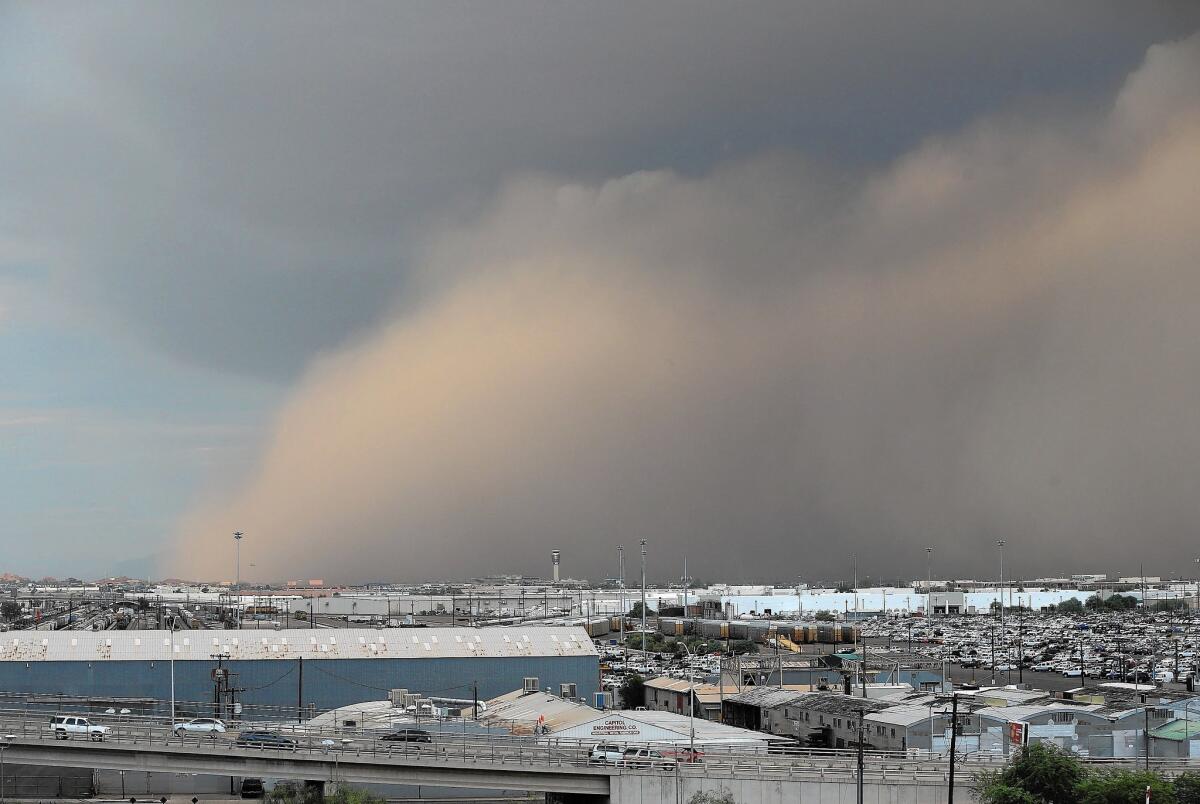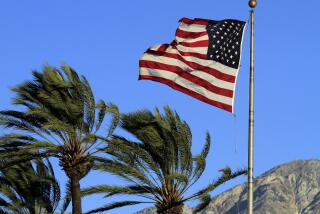Sandstorms give Phoenix a break from oppressive heat, but sometimes they turn deadly

Phoenix residents used to triple-digit heat aren’t fazed by lighter storms, but the wind and sand — and sometimes rain — can prove deadly.
- Share via
Reporting from Phoenix — The buzzing begins on restaurant tables and in gym lockers, usually in the late afternoon, when temperatures roar up to 110 degrees. Electronic devices rattle pockets and purses with an automated, chiding warning from the National Weather Service.
“Dust Storm Warning,” it reads. “Avoid travel.”
Longtime desert residents irritably silence their phones. Tourists smile and sweat a little and keep an eye on the windows.
Sometimes what they see is spectacular, from a distance — much of Arizona is best enjoyed from a distance: a wave of yellows and oranges and reds rolling in before faraway fountains of rain.
Then the sand hits.
Summer in the city of Phoenix is like living in an oven or a blow-dryer. “It’s a dry heat,” they all say, an explanation that has never been satisfactory to roasting chickens. Phoenix’s founders didn’t just design a metropolis in the middle of a desert; they elected to build the city in the Salt River Valley, where heat that blows away at higher elevations sits, trapped.
The hot season’s triple-digit temperatures can last into October, but there is one saving grace: The winds, usually blowing from the west, shift to bring moist air — there’s some debate whether it blows in from the Gulf of California or all the way from the Gulf of Mexico. The result is monsoon-season storms that crack the blanket of heat lying thick over the valley long after the sun sets, bringing relief amid rows of days that reach 110 degrees. Or 112. Or 115.
The storm systems blow in quickly, swept forward by a pressure front that stirs up acres of scrub and skinny pines and sand — most of all, sand.
Carried aloft by wind gusts, a curtain of loose silt and clay rolls in front of the miles-high column of barometric pressure like grim foreshadowing, and this is the price Phoenix pays for mercy from the heat.
It is called a haboob.
Thunderstorms stirred up in the middle of the desert take great gulps of the surrounding air into an updraft. Too heavy with air and water, the updraft stops, choked off. The thunderstorm then collapses, and a burst of rain and wind races down. Radar imagery shows it exploding on the ground in an orange and red wave, like a bomb.
The downdraft sends wind rushing in every direction, especially the direction the storm is traveling. With a total area of 516 square miles, larger than Los Angeles, the sprawling city of Phoenix often finds itself in the path of approaching storms.
Its residents, people who stay in Arizona in the summer, often by choice, have accepted the merciless temperatures and murderous fauna and are loath to let a little flying dirt interrupt their day, so they march on through lighter storms.
Last week the warnings sounded their buzzy alarm, but life went on without interruption. In such instances, the only evidence of a sandstorm comes later, in the wind whipping scattered dirt against windows and in the crunch of grit at dinnertime, like eating at a windy beach, when diners realize they’ve been walking around with mouths full of silt.
But sometimes, the wall of sand blows in thick, aided by water in the air, fogging the streets in a dense cloud that turns everything, briefly, to sepia.
It’s these storms that send grains of sand under doors and through car windows left cracked in the heat. The term “haboob,” which roughly translates from Arabic as “furious wind,” was introduced to Westerners in the 1800s to describe the towering columns of sand blowing across the Middle East.
Given the state’s recent dealings with people from neighboring countries, it is perhaps no surprise that Arizona residents have occasionally protested the linguistic import from the Middle East, including a letter to the editor of the Arizona Republic titled “Don’t call our dust storm haboobs.”
But there are serious, sometimes fatal, consequences to the storms too.
Official advice, when driving, is to pull over and wait out the storm. “Pull Aside, Stay Alive,” the state advises. This assumes drivers can still see the road.
Wind and sand aren’t the only danger. In a state where the summer brings out deadly snakes and deadly scorpions and the spikes on deadly plants, even the water in Arizona is trying to kill its residents.
The rains fall fast — too fast for the parched ground and gouged roads. Water pools in unexpected places, sometimes marked, sometimes not. Motorists have been trapped, or caught in the rapid flow and slammed against bridges.
Cities near dried-up riverbeds get the worst of it. Residents build berms around their properties, but it’s no use when 3 inches of rain falls, overrides the protective bank and swamps homes, sending mud careening across floors and over grassy backyards, covering them in silt.
And perhaps cruelest of all, sometimes the storms knock down power lines. People in this low, hot desert must then endure a day without the invention that provides the last excuse for this city to exist: air conditioning.
Twitter: @nigelduara
More to Read
Sign up for Essential California
The most important California stories and recommendations in your inbox every morning.
You may occasionally receive promotional content from the Los Angeles Times.











